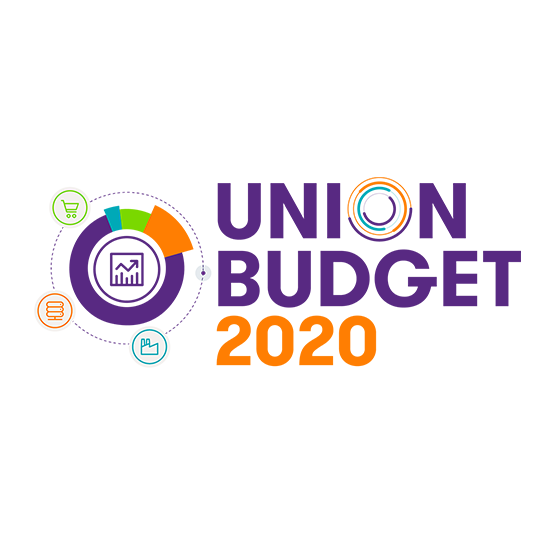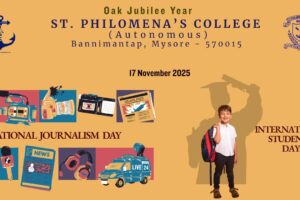
Panel discussion on Union Budget- 2020
The session on “Budget Analysis 2020” was organized on 13.02.20 by UG Department of Economics in collaboration with PG department Economics, UG department of Commerce, Management and PG department of Commerce. The session was witnessed by 140 students and 10 Lecturers of various streams.
The Budget session started with invocation song, followed by welcome speech and introduction of panel speakers. The panel discussion was headed by Dr. R Nagabhusan, Asst. Prof. Dept of Economics, Mysuru, Dr. S R Keshava, Professor, Dept of Economics, JnanaBharthi Campus, Bangalore University and Dr. Premakumar G S, Faculty of Economics, Sir M V PG centre, Mandya were the eminent speakers who enthralled the gathering with their impeccable knowledge on budget 2020.
Dr. S R Keshava started with the quotes that “The budget is not just the collection of numbers, but an expression of our values and aspirations” – Jacob blew. The speaker in his speech exemplified the health of Indian economy through facts and figures. There is a sharp decline in GDP rate, saving rate, gross fixed capital formation rate, index of Industrial production growth, Gross fiscal deficit and revenue deficit percentage. He emphasized that the future global economic is highly unpredictable due to geo political tensions and there is a paramount challenges ahead such as, slow down in manufacturing, trade, demand, steep price of commodities, crude oil etc. increasing unemployment, inequality, rural distress, shortfall in tax collection (16.5 lakh crore was estimated but only 13.7 crore was the forecast) and decline in consumption expenditure.
- The speaker focused on three prominent themes of 2020 budget, they are:
- Aspirational India: Where better standard living with access to health, education and better jobs for all sections of the society will be provided.
2.Economic Development for all: “SabkaSaath ,SabkaVikas , SabkaVishwas”.
3.Caring Society:
- Caring society by being humane and compassionate.
- Corruption free, policy-driven Good Governance.
- Clean and sound financial sector.
- Ease of Livingunderlined by the three themes of Union Budget 2020-21.
Highlights of the budget was sixteen action plans for agriculture, irrigation and rural development, Rs. 69,000 crore allocation for healthcare sector, Rs. 64,000 for PM janarogyayojana, janaushadhi Kendra scheme to offer 2000 medicines and 300 surgical in all districts by 2024, every district hospital to have medical college attached to alleviate shortage of doctors, new education policy, internship for young engineers, by march 2021 about 150 higher education to start apprenticeship for the students, FDI for educational sectors, involving young engineers, management graduates and economists of universities for infrastructure projects, 27,300 crore allocated for 2020-21 development and promotion of Industry and Commerce and new tax slabs. The speaker ended his session by addressing the negative impact of LIC disinvestment, FDI in education and Contract farming.
The second session was addressed by Dr. Premakumar G S. who explained the difference between budget analysis and budget work, in contrast, can include budget analysis, but encompasses work such as expenditure tracking of various sorts, assessments of the impact of government expenditures, community education with regard to the budget, advocacy related to the way the budget impacts the poor and so on.
Some of the realities with reference to India’s performance were emphasized by the speaker they are:
- India’s improved ranking in the World Bank’s ‘Ease of Doing Business’ Index(from 130 to 100) have been cause for much celebration. However, coinciding with this is the news that out of the 180 countries assessed, India ranks low in the Environmental Performance Index(EPI) 2018, slipping from rank 141 in 2016, to 177 in 2018. We are just two rungs above Nepal and Burundi.
- In environmental health, India ranked 178 in air quality, 145 in water and sanitation and 175 in heavy metals. The report said there is “an urgent need to ramp up sanitation efforts in India”.
- Ecosystem vitality of India ranked 125 in agriculture, 131 in air pollution, 139 in biodiversity and habitat, 120 in climate and energy, 53 in fisheries, 68 in forests and 107 in water resources.
The speaker apprised the challenges before the finance minister was growth, employment, inflation, inequality and twin deficits. The session emphasized the significant aspects of the budget to revive the growth were, Agriculture 1.5 Lakh to 2.83 Lakh, Rural Development 1.4 Lakh to 1.23 lakh, 20 Lakh, Agriculture Solar pumps and grid connectivity, employment generation in railway, education, health and sanitation, 100 airports and doubling the number of airplanes, doubling farmers income by 2022, focusing on wellness, water and sanitation, setting up knowledge translation clusters for emerging technology sectors, scaling up technology clusters harboring test beds and small scale manufacturing facilities. The major missing factors in the union budget 2020-2021 were big bang steps taken for reviving consumption, investment and creating jobs for the populace.
The second session ended with issues that concern India, i.e. negligence in conserving nature, because two-thirds of the world’s most polluted cities are in India, which shortens lives and lowers productivity and reduces the capacity to earn a living. The speaker also stated the sustainable development-multiple models such as, manufactured, natural, human and social capital. In addition to these models he also addressed financial and intellectual capital which will foster sustainable development.
Thus, Budget analysis 2020, informative and enlightening session ended with question and answer and vote of thanks.




